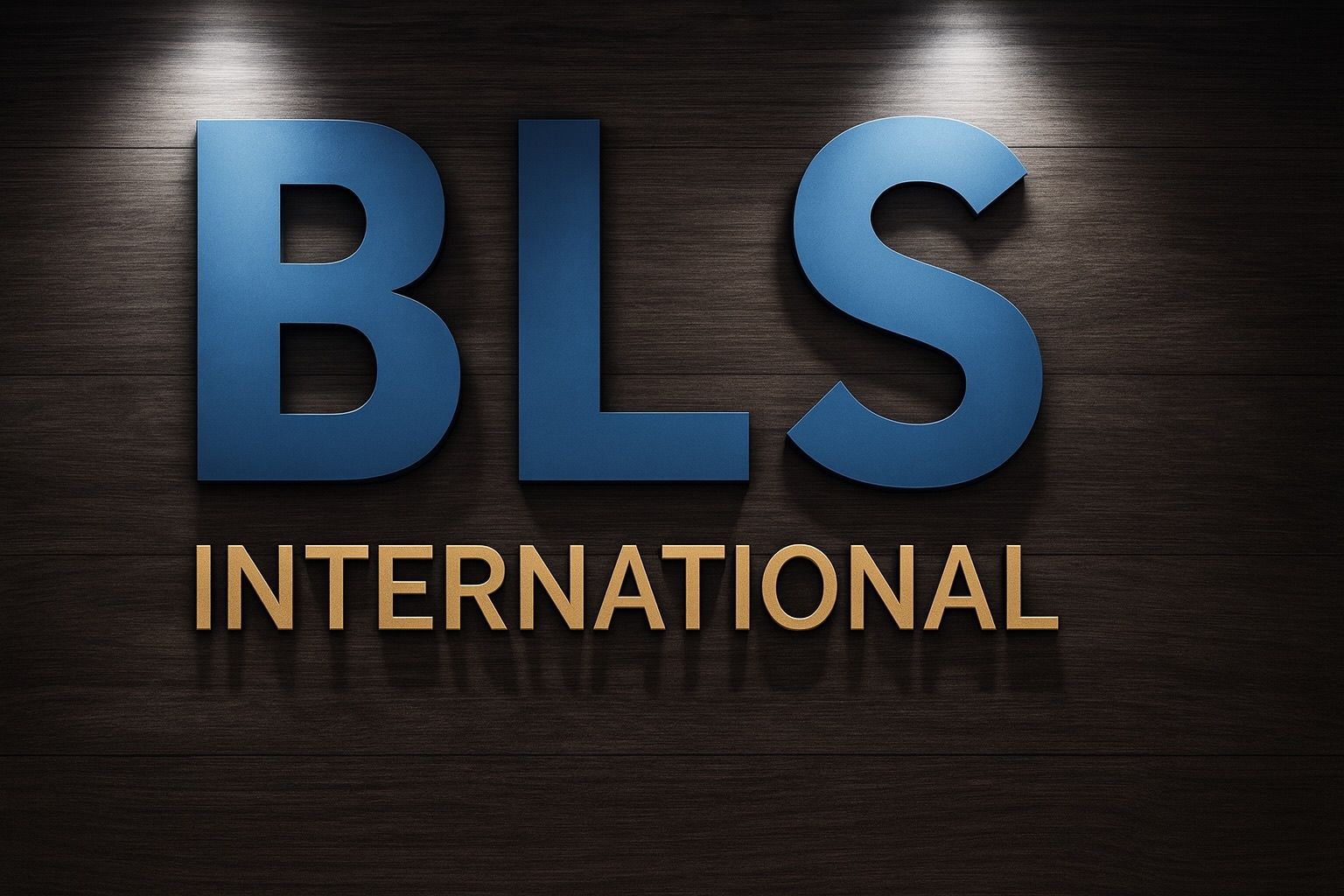Key facts: – India’s Ministry of External Affairs (MEA) on Oct 9, 2025 barred BLS International from bidding on any new visa/passport outsourcing contracts with Indian embassies and missions for the next two years [1] [2]. The MEA order cited unspecified court cases and applicant complaints as the reason [3] [4].
- Existing contracts unaffected: BLS clarified that all ongoing deals with Indian Missions (about 12% of FY26 Q1 revenue [5] [6]) will continue as scheduled; only future tenders are blocked [7] [8].
- Shares crash: The stock sank ~18% on Oct 13 to a ~52-week low (₹276.95) [9], then traded around ₹290–₹300 midday (down ~12–13%) [10] [11]. This was its steepest one-day fall since 2020, making BLS the biggest loser on the small-cap index [12] [13]. YTD the shares are down ~39% (vs. small-cap index –4%), though still up ~1,400% over five years [14] [15].
- Limited near-term impact: Indian government missions only contributed ~12% of BLS’s revenue and ~8% of EBITDA [16] [17], so analysts say the ban has “no significant bearing on the company’s financial outlook” [18]. BLS’s core business (visa/passport processing, biometric services, etc.) in 60+ countries [19] [20] will continue, and the firm points to large new contracts (e.g. a ₹2,055-cr UIDAI/Aadhaar center deal [21]) and acquisitions (iDATA, Citizenship Invest) to bolster growth [22] [23].
- Company response: BLS called the ban a “procedural development” and said it is “working to resolve the matter” [24] [25]. Management stressed that operations and cashflows are intact, and even said it is evaluating legal action against the MEA order [26]. It reiterated strong fundamentals – a “diversified business portfolio” across the US, UAE, Europe and recent domestic wins – to weather this phase [27] [28].
- Analyst outlook: Experts warn the ban is a reputational setback that could dent BLS’s pitch for future government deals [29]. However, they note BLS’s global footprint should mitigate losses – “the company’s diversified global presence will help limit the overall financial impact,” says one report [30] [31]. Technical forums and analysts see the current slide as a buying opportunity: BLS’s consensus 12-month price target is around ₹604 (about double the current price) [32]. For example, broker Nuvama recently reiterated a BUY on BLS with a target of ₹637 [33], and Bloomberg data shows an implied target ~₹665 (125% upside) [34]. Market analysts (e.g. TS2.Tech) nonetheless urge caution – one noted the market is “poised between continued euphoria and a potential correction” [35], advising hedges like gold amid uncertainty [36].
Government Ban and Stock Reaction
On Oct 9 the MEA quietly issued a directive barring BLS International Services Ltd. from participating in any new tenders issued by the Ministry of External Affairs or India Missions abroad [37] [38]. The order cited undisclosed court cases and complaints against BLS’s service (such as visa/passport processing delays), but gave no detail on specific incidents [39] [40]. BLS confirmed the order over the weekend (via an Oct 11 exchange filing), and assured investors that “all existing contracts…remain valid and continue to operate as scheduled” [41]. In practice, the ban only prevents BLS from bidding on future government contracts – current visa and passport centers run by BLS for various embassies and consulates will keep operating normally [42] [43].
Despite the limited scope, the news spooked investors. On Oct 13 the stock crashed roughly 18%. Shares slumped to a new 52-week low of ₹276.95 on the BSE [44], before recovering slightly. Reuters reported BLS was down over 13% to about ₹294.30 by 11:44am IST (versus around ₹337 just before the ban) [45]. Moneycontrol confirmed the slide, noting BLS was the top loser on the Nifty 500 index that day [46]. The fall erased much of BLS’s 2025 gains: the stock has lost ~39% YTD [47] (while the small-cap index is off only ~4%), although it remains far above its levels from a few years ago (roughly +1,455% over five years [48]).
Business Impact and Company Response
In economic terms the ban is a minor setback for BLS’s near-term finances. Indian Missions contributed only about 12% of BLS’s consolidated revenue (≈8% of EBITDA) in Q1 FY26 [49] [50]. BLS management has stressed that the current financials and cash flows are largely unaffected. In its filings the company explicitly said the MEA order “will not have any significant bearing on the company’s financial outlook” [51]. All ongoing projects (visa application processing, passport renewals, biometric enrollments, etc.) will continue under existing terms [52] [53], so NRI customers and foreign governments should see no service disruption in the short term.
BLS also pointed out its diversified business mix. It operates in over 60 countries, handling visa/passport services for numerous foreign missions (e.g. USA, UK, Spain, UAE, etc.) [54] [55]. In recent years BLS has expanded internationally and into related areas – acquiring iDATA and Citizenship Invest in FY2025 and winning a ₹2,055-cr contract to run Aadhaar Seva Kendras for UIDAI [56] [57]. These moves reduce reliance on any single client or region. As one industry report notes, BLS’s acquisitions have “strengthened its foothold” in global citizenship, attestation and digital services, giving it “resilience against regional developments” [58] [59]. In short, analysts believe BLS can offset the MEA ban by leaning on its overseas contracts and other domestic wins.
Still, the ban does introduce a reputational risk. MEA contracts are high-profile, and being officially debarred could make other governments or clients wary. Many analysts therefore treat the development as a caution flag. Economic Times quoted market experts saying the ban is “a reputational challenge” and could dent BLS’s bidding confidence abroad [60]. BLS management acknowledged the seriousness, calling the order a “procedural development within the visa outsourcing industry” [61] [62]. The firm says it is “working to resolve the matter” and expects a “constructive resolution” eventually [63]. It even noted it is exploring legal action against the MEA’s directive [64]. Meanwhile, BLS emphasises its strong growth track record and fundamentals to reassure investors [65] [66].
Analysts’ Forecast and Market Outlook
Analysts were quick to churn out guidance. Most maintain buy ratings, arguing the fundamentals remain solid. For example, Nuvama Securities recently reiterated a BUY on BLS, lifting its 12-month target to ₹637 (about +60% upside) based on Q3FY25 earnings trends [67]. According to aggregated data on Trendlyne, the consensus 1-year price target for BLS is around ₹604 [68] – roughly double the pre-ban price. Bloomberg data (as reported by NDTV) even shows a single covering analyst (Nuvama) implying a ₹665 target (125% upside) [69]. In short, brokers generally think the sell-off is overdone.
Of course, broader market conditions are mixed. Heading into mid-October 2025, global equity indices had just hit new highs, fueled by tech/AI optimism and expected Fed rate cuts [70] [71]. However, geopolitical and economic jitters are mounting (trade tensions, U.S. shutdown, etc.). A TS2.Tech market analysis this week warned that “no clear trend signal” exists at current peaks and that markets are “poised between continued euphoria and a potential correction” [72]. Another TS2 note similarly counseled caution – saying “drums of worry are banging louder each day” and investors should hedge with safe assets like gold [73]. These views suggest that while BLS’s long-term story may be intact, the near-term technical outlook is volatile.
In summary, BLS’s management and backers emphasize that operations and cash flows remain robust, and they expect the ban’s impact to be contained. If and when the MEA issue is cleared (or if BLS wins new tenders), analysts say the stock could bounce sharply (many targets imply 2× upside) [74] [75]. Until then, however, investors are watching carefully. The consensus is that BLS’s diversified global business will carry it through this turbulence [76] [77], but a protracted government ban or legal battle could slow growth and keep the stock subdued.
Sources: Business and market reports from Economic Times, Moneycontrol, LiveMint, NDTV, Business Today, and TS2.Tech, as well as the company’s filings [78] [79] [80] [81] [82] [83]. These provide the latest facts on BLS International’s MEA ban, share performance, financials, and expert commentary.
References
1. www.reuters.com, 2. economictimes.indiatimes.com, 3. www.reuters.com, 4. economictimes.indiatimes.com, 5. economictimes.indiatimes.com, 6. www.moneycontrol.com, 7. economictimes.indiatimes.com, 8. www.moneycontrol.com, 9. www.moneycontrol.com, 10. www.moneycontrol.com, 11. trendlyne.com, 12. www.reuters.com, 13. www.moneycontrol.com, 14. www.moneycontrol.com, 15. www.livemint.com, 16. www.ndtvprofit.com, 17. economictimes.indiatimes.com, 18. www.moneycontrol.com, 19. economictimes.indiatimes.com, 20. www.tipranks.com, 21. economictimes.indiatimes.com, 22. economictimes.indiatimes.com, 23. www.businesstoday.in, 24. www.businesstoday.in, 25. www.moneycontrol.com, 26. www.moneycontrol.com, 27. www.businesstoday.in, 28. www.businesstoday.in, 29. economictimes.indiatimes.com, 30. economictimes.indiatimes.com, 31. www.businesstoday.in, 32. trendlyne.com, 33. www.livemint.com, 34. www.ndtvprofit.com, 35. ts2.tech, 36. ts2.tech, 37. www.reuters.com, 38. economictimes.indiatimes.com, 39. www.reuters.com, 40. economictimes.indiatimes.com, 41. www.moneycontrol.com, 42. economictimes.indiatimes.com, 43. www.businesstoday.in, 44. www.moneycontrol.com, 45. www.reuters.com, 46. www.moneycontrol.com, 47. www.moneycontrol.com, 48. www.livemint.com, 49. economictimes.indiatimes.com, 50. www.ndtvprofit.com, 51. www.moneycontrol.com, 52. economictimes.indiatimes.com, 53. www.businesstoday.in, 54. economictimes.indiatimes.com, 55. www.tipranks.com, 56. economictimes.indiatimes.com, 57. economictimes.indiatimes.com, 58. economictimes.indiatimes.com, 59. www.businesstoday.in, 60. economictimes.indiatimes.com, 61. www.moneycontrol.com, 62. www.businesstoday.in, 63. www.businesstoday.in, 64. www.moneycontrol.com, 65. www.moneycontrol.com, 66. www.businesstoday.in, 67. www.livemint.com, 68. trendlyne.com, 69. www.ndtvprofit.com, 70. ts2.tech, 71. ts2.tech, 72. ts2.tech, 73. ts2.tech, 74. trendlyne.com, 75. www.livemint.com, 76. economictimes.indiatimes.com, 77. www.businesstoday.in, 78. www.reuters.com, 79. www.moneycontrol.com, 80. economictimes.indiatimes.com, 81. economictimes.indiatimes.com, 82. www.ndtvprofit.com, 83. www.livemint.com







